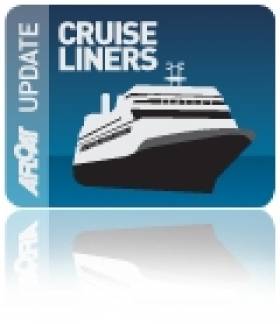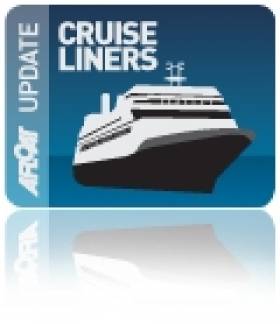Displaying items by tag: Sea Cloud II
Exclusive 5-Star Luxury Sailing Cruiseship, Sea Cloud II Spends Time Touring Irish Ports
#SailingCruiseship- As previously reported on Afloat.ie, a trio of cruise callers due to Dublin Port arrived this morning, among them the exclusive Sea Cloud II (2001/3,849grt), a 5 star luxury sail-assisted vessel, writes Jehan Ashmore.
The 117m/ 384ft Spanish built windjammer cruiseship operated by Sea Cloud Cruises, yesterday called to Belfast Harbour. On her arrival today she berthed next to the East-Link Bridge, bringing her mere 94 guest higher spending power clientele closer to the capital's centre.
Of her three masts, the mainmast towers 57m or 187 ft above deck and in total she sets 23 sails totalling 3,000 m² / 32,000 sq ft. Alternatively she has use of engine power (2 X 1,240 kW) producing around 14 knots.
So what passenger facilities are available, there is a lido deck with bar, restaurant, lounge, boutique, library with laptop, sauna, fitness area, a swim platform and a hospital.
Of her 47 outside cabins, 29 of them have a shower/WC, 16 junior suites with bathtub/WC and 2 luxury owner suites. Take a peek HERE, at one of these luxury suites (No. 402) which is 27 m² / 290 sq ft and features a King-sized bed. The bathroom with marble sink and golden fixtures, exude an ambiance of sheer luxury. Click the photo of the suite to enlarge for a better view.
All cabin categories of the top end luxury cruiseship are furnished with bathrobes, hair dryer, telephone, adjustable A/C, private safe, TV/DVD and a mini-bar.
This evening she bids the capital farewell with a departure time of 18.30. Having entered Dublin Bay she is to set a course for Cork Harbour.
Unlike the majority of cruiseships that head for Cobh or smaller sized callers which could head upriver to Cork city-quays, the exclusive Sea Cloud II is an exception.
Instead her guests will have ultimate privacy by anchoring in the lower harbour when she is due to arrive around lunchtime tomorrow.
Modern Windjammer Cruiseship Returns to Dublin Port
#TallCruiseShip – Sea Cloud II returned to Dublin Port today and is clearly visible to motoring commuters using the East-Link Bridge, to where she is berthed nearby, writes Jehan Ashmore.
On her previous visit earlier this month, the 2001 built luxurious Maltese flagged barque had moored alongside Sir John Rogersons Quay, however todays arrival at the North Wall Extension is also where P&O Ferries operate daily services to Liverpool.
Sea Cloud II has a capacity for just 64 guests who have the added experience of cruising under her three masts which give a total sail area of approximately 32,150 sq. feet (3.000 m²). Operated by Sea Cloud Cruises, the 117m cruiseship belongs to a select fleet of vessels which have the added option of sail-assisted power.
Recent examples to Irish waters have been the Wind Surf which visited Dun Laoghaire Harbour and her sister Club Med 2 to Dublin Port. Both vessels have also made calls to other Irish ports before their Dublin Bay arrivals and this applied to Sea Cloud II which last night sailed from Belfast Harbour.
The cruiseship is scheduled to depart Dublin Port around 19.30hrs.
Majestic Tall-Cruise-Ship With White Clouds Too
#TallCruiseShip- One good easily think another tallship visitor has called to Dublin Port, however what makes the majestic 117m Sea Cloud II stand out is not just beauty but that she is a cruiseship and with a mere 64 guests on board the luxury vessel, writes Jehan Ashmore.
The three-masted Sea Cloud II is to remain berthed overnight in the capital tonight, so allowing her guests another day to explore having docked early this morning from Cork Harbour. She is berthed at Sir John Rogersons Quay within the 'Docklands' Quarter of the city.
Despite her appearance, the barque was only built in 2001 and she can set a total sail area of approximately 32,150 sq. feet (3.000 m²), noting to scroll down the page for sail-plan.
Operated by Sea Cloud Cruises the Maltese flagged vessel is berthed between the Samuel Beckett swing-bridge and the East-Link toll-lift bridge. Should you be around including those taking a lunch-break in the neighbouring office- blocks, a closer inspection is worth the stroll along the campshires.
Sea Cloud II is scheduled to depart around teatime tomorrow and she follows exactly a week ago to the departure of the five-masted Club Med II which despite not setting sails still made for a refreshingly different 'cruiseship' sight as she glided out of Dublin Bay.
The final member of this trio of 'sail-assisted' cruiseships visiting our shores Wind Surf is to make an anchorage call off Dunmore East next Tuesday and a call to Dun Laoghaire also next week.































































